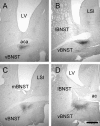Noradrenaline transmission within the ventral bed nucleus of the stria terminalis is critical for fear behavior induced by trimethylthiazoline, a component of fox odor
- PMID: 15976089
- PMCID: PMC6724787
- DOI: 10.1523/JNEUROSCI.1028-05.2005
Noradrenaline transmission within the ventral bed nucleus of the stria terminalis is critical for fear behavior induced by trimethylthiazoline, a component of fox odor
Abstract
The bed nucleus of the stria terminalis (BNST) is involved in the mediation of fear behavior in rats. A previous study of our laboratory demonstrated that temporary inactivation of the BNST blocks fear behavior induced by exposure to trimethylthiazoline (TMT), a component of fox odor. The present study investigates whether noradrenaline release within the BNST is critical for TMT-induced fear behavior. First, we confirmed previous studies showing that the ventral BNST is the part of the BNST that receives the densest noradrenaline innervation. Second, using in vivo microdialysis, we showed that noradrenaline release within the BNST is strongly increased during TMT exposure, and that this increase can be blocked by local infusions of the alpha2-receptor blocker clonidine. Third, using intracerebral injections, we showed that clonidine injections into the ventral BNST, but not into neighboring brain sites, completely blocked TMT-induced potentiation of freezing behavior. The present data clearly show that the noradrenergic innervation of the ventral BNST is important for the full expression of behavioral signs of fear to the predator odor TMT.
Figures





Similar articles
-
Temporary inactivation of the bed nucleus of the stria terminalis but not of the amygdala blocks freezing induced by trimethylthiazoline, a component of fox feces.J Neurosci. 2003 Jan 1;23(1):23-8. doi: 10.1523/JNEUROSCI.23-01-00023.2003. J Neurosci. 2003. PMID: 12514197 Free PMC article.
-
Inactivation of the lateral septum blocks fox odor-induced fear behavior.Neuroreport. 2008 Apr 16;19(6):667-70. doi: 10.1097/WNR.0b013e3282fb78d9. Neuroreport. 2008. PMID: 18382283
-
Behavioral effects and pattern of brain c-fos mRNA induced by 2,5-dihydro-2,4,5-trimethylthiazoline, a component of fox feces odor in GAD67-GFP knock-in C57BL/6 mice.Behav Brain Res. 2009 Sep 14;202(2):218-24. doi: 10.1016/j.bbr.2009.03.038. Epub 2009 Apr 5. Behav Brain Res. 2009. PMID: 19463704
-
Analysis of behavioral constraints and the neuroanatomy of fear to the predator odor trimethylthiazoline: a model for animal phobias.Neurosci Biobehav Rev. 2008 Sep;32(7):1267-76. doi: 10.1016/j.neubiorev.2008.05.006. Epub 2008 May 13. Neurosci Biobehav Rev. 2008. PMID: 18619675 Review.
-
The smell of danger: a behavioral and neural analysis of predator odor-induced fear.Neurosci Biobehav Rev. 2005;29(8):1157-67. doi: 10.1016/j.neubiorev.2005.04.008. Epub 2005 Aug 10. Neurosci Biobehav Rev. 2005. PMID: 16095694 Review.
Cited by
-
Both α1- and β1-adrenoceptors in the bed nucleus of the stria terminalis are involved in the expression of conditioned contextual fear.Br J Pharmacol. 2012 Sep;167(1):207-21. doi: 10.1111/j.1476-5381.2012.01985.x. Br J Pharmacol. 2012. PMID: 22506532 Free PMC article.
-
Effects of noradrenergic alpha-2 receptor antagonism or noradrenergic lesions in the ventral bed nucleus of the stria terminalis and medial preoptic area on maternal care in female rats.Psychopharmacology (Berl). 2012 Nov;224(2):263-76. doi: 10.1007/s00213-012-2749-2. Epub 2012 May 29. Psychopharmacology (Berl). 2012. PMID: 22644129 Free PMC article.
-
Genetic disruption of dopamine β-hydroxylase dysregulates innate responses to predator odor in mice.Neurobiol Stress. 2024 Feb 2;29:100612. doi: 10.1016/j.ynstr.2024.100612. eCollection 2024 Mar. Neurobiol Stress. 2024. PMID: 38371489 Free PMC article.
-
Role of bed nucleus of the stria terminalis corticotrophin-releasing factor receptors in frustration stress-induced binge-like palatable food consumption in female rats with a history of food restriction.J Neurosci. 2014 Aug 20;34(34):11316-24. doi: 10.1523/JNEUROSCI.1854-14.2014. J Neurosci. 2014. PMID: 25143612 Free PMC article.
-
Corticotropin-releasing factor and noradrenergic signalling exert reciprocal control over startle reactivity.Int J Neuropsychopharmacol. 2011 Oct;14(9):1179-94. doi: 10.1017/S1461145710001409. Epub 2010 Dec 21. Int J Neuropsychopharmacol. 2011. PMID: 21205416 Free PMC article.
References
-
- Aliaga E, Bustos G, Gysling K (1995) Release of endogenous catecholamines from the striatum and bed nucleus of stria terminalis evoked by potassium and N-methyl-d-aspartate: in vitro microdialysis studies. J Neurosci Res 40: 89-98. - PubMed
-
- Bailey JE, Argyropoulos SV, Lightman SL, Nutt DJ (2003) Does the brain noradrenaline network mediate the effects of the CO2 challenge? J Psychopharmacol 17: 252-259. - PubMed
-
- Blanchard DC, Griebel G, Blanchard RJ (2003a) Conditioning and residual emotionality effects of predator stimuli: some reflections on stress and emotion. Prog Neuropsychopharmacol Biol Psychiatry 27: 1177-1185. - PubMed
-
- Blanchard DC, Markham C, Yang M, Hubbard D, Madarang E, Blanchard RJ (2003b) Failure to produce conditioning with low-dose trimethylthiazoline or cat feces as unconditioned stimuli. Behav Neurosci 117: 360-368. - PubMed
-
- Blanchard RJ, Blanchard DC (1969) Crouching as an index of fear. J Comp Physiol Psychol 67: 370-375. - PubMed
Publication types
MeSH terms
Substances
LinkOut - more resources
Full Text Sources
